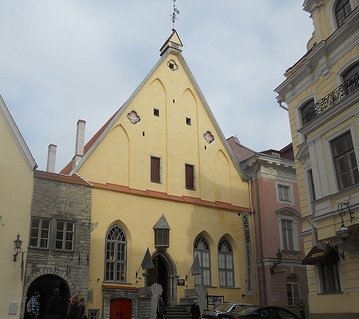

Pikk jalg 17
Tel. 641 1630
Bus: 5, 40 Trolley: 1, 2, 3, 4
Open: 11am- 6pm Thu- Tue
Estonian History Museum
Open: Mar-
Oct 11am- 6pm Wed- Sun
Nov- Feb 11am- 5pm
www.eam.ee
Great Guild Hall was constructed in 1417 as a gathering place for powerful union of wealthy merchants known as a Great Guild. The building kept its original structure with windows opened in 1890's.


The big guild united only the merchants of the Lower City. From the
very beginning it was a secular organization, therefore it did not have
its patron saint, unlike other guilds. It had its own coat of arms and
charter. To join the guild, the candidate must:
To be rich, have
your own house, business and be married.
Pay an entry fee.
Enlist
the guarantee of two current members of the guild.
Only members of
the Great Guild in the Lower City were allowed to wear gold chains,
velvet and brocade clothing, and furs.
The guild built its building in 1407-1410. on Pikk Street (house 17),
the central one in the medieval Lower Town. She acquired the land for
construction in the spring of 1406, having bought the house of the late
burgomaster Schotelmund. The position of the Great Guild was dominant at
that time, since the magistrate consisted of rich merchants, so the
guild easily received permission to demolish the purchased house.
Partially on its foundation, a guild building was erected, which
stretched over the entire narrow section from Pikk Street to Lai Street,
capturing the territory of the former courtyard and outbuildings of the
previous owner, which is still visible in the basement of the building
along its foundation. At the same time, a small triangular square was
built in front of the building.
The building was probably built
under the direction of the master Gercke, its main facade with a gable
facing the street has largely retained its original appearance.
The building of the Great Guild is a one-story building with a powerful
gable roof, its facade (16.8 meters wide, 20.5 meters high) with a high
gable is somewhat moved away from the red line of the street. The facade
of the building has been preserved in its original form. The tong is
decorated with four lancet niches, in the middle there are commodity
hatches, and four-bladed niches, inside of which there is a small coat
of arms of Tallinn, which is also the coat of arms of the guild. Only
the windows were converted into lancet windows at the end of the 19th
century, like many buildings in the Old Town. On the ridge of the roof
is the date of completion of construction - 1410. The great hall of the
guild has retained its 15th-century Gothic style.
There are
beautiful brass rosettes on the doors. The beaters in the form of lion
heads were cast by master Merten Seifert in 1430; on the right hammer
the Latin inscription
anno-domini-millesimo-ccccxxx-o-rex-glorie-xpe-veni-in-pace (in the year
of the Lord one thousand 430, the glorious King Christ come in peace).
On the left hammer there is an inscription in Low German:
got-d'-ghebenediet-al-dat-hus-is-vnde-noch-kommensal (God bless all who
are in this house and who come here).
In 1413, additional
premises were built: above the arch on Pikk Street - an excise chamber,
above the arches on Lai Street - the bride's chamber, and others. In the
guild house, according to custom, they not only held ceremonies and
celebrations, but also celebrated weddings and, as usual, the newlyweds
also spent the first night here.
A complex two-stage portal with
a simple, modest impost, located asymmetrically to the axis of the
facade, follows the shape of the portal of the Tallinn City Hall. The
porch, located in front of the main portal, was dismantled, and a
fragment of a relief with a rose decorating it was used as a console for
a lantern above the portal. Initially, the windows were rectangular;
their current lancet shape belongs to the 2nd half of the 19th century.
Today, the premises of the Guild House host expositions of the
Estonian History Museum: an exhibition of coins and means of payment
from different eras, an exhibition of weapons and armor, an exposition
"The Soul of a Thing", dedicated to unusual old household items. In the
building of the Great Guild, documentaries about the history of Estonia
and its capital, merchant corporations, the life and customs of the
merchants are shown daily, interactive quizzes and games are held.